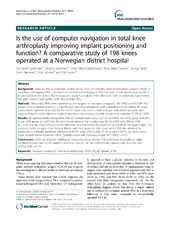| dc.contributor.author | Dyrhovden, Gro Sævik | en_US |
| dc.contributor.author | Gøthesen, Øystein Johannes | en_US |
| dc.contributor.author | Lygre, Stein Håkon Låstad | en_US |
| dc.contributor.author | Fenstad, Anne Marie | en_US |
| dc.contributor.author | Sørås, Tor Egil | en_US |
| dc.contributor.author | Halvorsen, Svein | en_US |
| dc.contributor.author | Jellestad, Truls | en_US |
| dc.contributor.author | Furnes, Ove | en_US |
| dc.date.accessioned | 2014-09-16T07:58:51Z | |
| dc.date.available | 2014-09-16T07:58:51Z | |
| dc.date.issued | 2013-11-14 | eng |
| dc.identifier.issn | 1471-2474 | |
| dc.identifier.uri | https://hdl.handle.net/1956/8478 | |
| dc.description.abstract | Background: There are few Scandinavian studies on the effect of computer assisted orthopedic surgery (CAOS) in total knee arthroplasty (TKA), compared to conventional technique (CON), and there is little information on effects in pain and function scores. This retrospective study has evaluated the effects of CAOS on radiological parameters and pain, function and quality of life after primary TKA. Methods: 198 primary TKAs were operated by one surgeon in two district hospitals; 103 CAOS and 95 CON. The groups were evaluated based on 3 months post-operative radiographs and a questionnaire containing the knee osteoarthritis outcome score (KOOS), the EQ-5D index score and a visual analogue scale (VAS) two years after surgery. Multiple linear regression method was used to investigate possible impact from exposure (CON or CAOS). Results: On hip-knee-ankle radiographs, 20% of measurements were > ±3° of neutral in the CAOS group and 25% in the CON group (p = 0.37). For the femoral component, the number was 5% for CAOS and 18% for CON (p < 0.01). For the tibial component, the difference was not statistically significant (p = 0.58). In the sagittal plane, the surgeon tended to apply more femoral flexion and more posterior tibial slope with CAOS. We observed no statistically or clinically significant difference in KOOS score, VAS or ΔEQ-5D (all p values >0.05), but there was a trend towards better scores for CAOS. Operation time was 3 minutes longer for CON (p = 0.37). Conclusions: CAOS can improve radiological measurements in primary TKA, and makes it possible to adjust component placement to the patient’s anatomy. Over-all, the two methods are equal in pain, function and quality-of-life scores. | en_US |
| dc.language.iso | eng | eng |
| dc.publisher | BioMed Central | eng |
| dc.rights | Attribution CC BY | eng |
| dc.rights.uri | http://creativecommons.org/licenses/by/2.0 | eng |
| dc.subject | Computer navigation | eng |
| dc.subject | Total knee arthroplasty | eng |
| dc.subject | KOOS | eng |
| dc.subject | EQ-5D | eng |
| dc.subject | Quality of life | eng |
| dc.title | Is the use of computer navigation in total knee arthroplasty improving implant positioning and function? A comparative study of 198 knees operated at a Norwegian district hospital | en_US |
| dc.type | Peer reviewed | |
| dc.type | Journal article | |
| dc.date.updated | 2013-11-19T16:08:33Z | |
| dc.description.version | publishedVersion | en_US |
| dc.rights.holder | Copyright 2014 Dyrhovden et al.; licensee BioMed Central Ltd. | |
| dc.rights.holder | Gro Sævik Dyrhovden et al.; licensee BioMed Central Ltd. | |
| dc.source.articlenumber | 321 | |
| dc.identifier.doi | https://doi.org/10.1186/1471-2474-14-321 | |
| dc.identifier.cristin | 1068388 | |
| dc.source.journal | BMC Musculoskeletal Disorders | |
| dc.source.40 | 14 | |

